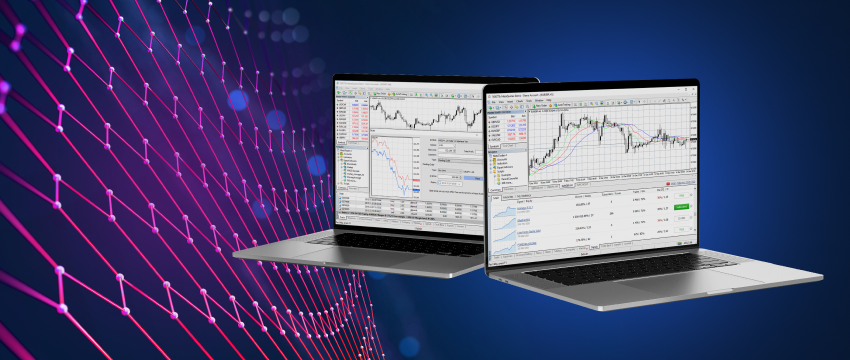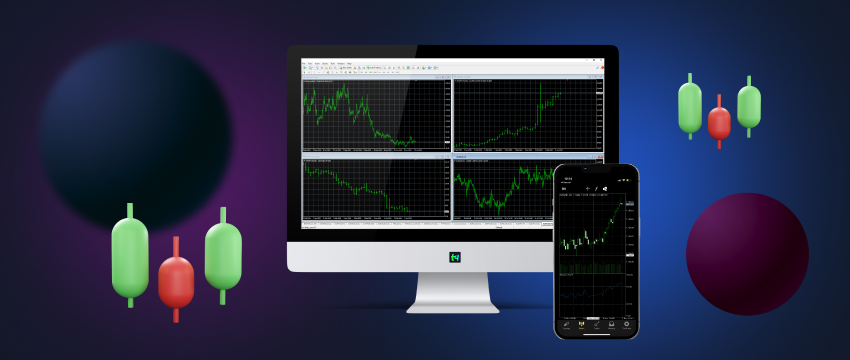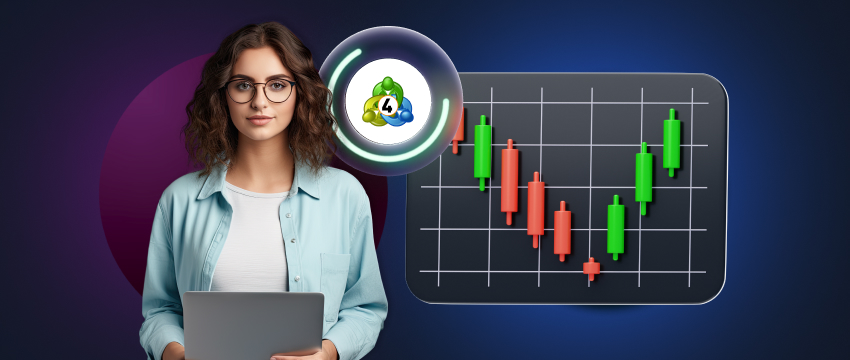Knowledge, education, practice, and consistency are key to refining your skills as an online forex trader. But to get to the level that you want to be, it’s important to define your goals and how you’ll achieve them successfully. To do this requires a good understanding of the forex market, how it operates, and a trading style that is best suited to you.
In this article, we’ll touch on what the forex market is, how to start trading forex, and trading styles adopted by forex trading brokers worldwide.

Starting with what the forex market is
The foreign exchange market (more commonly known as the forex or currency market) is a global marketplace through which different national currencies are traded electronically. Simply put, it’s where forex traders go to buy, sell, exchange, or speculate on currencies online.
The forex market is the biggest decentralised market in the world, composed of thousands of banks, brokerages, investors, and individual traders located in countries across the globe. With trillions of dollars being traded daily, it is also the most liquid market globally.
The forex market dictates the daily value (i.e., the exchange rate) of currencies worldwide. Currencies are listed in pairs, for example, GBP/USD (i.e., GBP vs USD), EUR/USD (EUR vs USD), USD/CAD (USD vs the Canadian Dollar), etc. They are quoted in pips (percentage in points) and are traded in micro, mini or standard lots.
London, New York, Singapore, Hong Kong, and Tokyo dominate forex trading.

How does trading in the forex market work?
The forex market is open 24 hours a day, five days a week, with three trading sessions that include the European, Asian and US trading sessions. The entire exchange happens electronically, with certain currency pairs having more volume than others, depending on the session they are traded in.
Forex trading is always done in pairs. This means forex traders must buy one currency and sell another at the same time.
What are pips in forex trading?
Currencies are priced in pips, usually to the fourth or fifth decimal point, except for currency pairs that include the Japanese Yen as the quote currency. In this case, the pairs are usually priced out to 2 or 3 decimal places.
Pips are used to measure the change in a currency value relative to another.
What do we mean by lots in forex trading?
Forex is typically traded in different-sized lots. A lot is a measure of currency units considered suitable for buying or selling. The sizing of lots to units typically looks as follows:
- Standard lot: 100,000 units of currency
- Mini lot: 10,000 units of currency
- Micro lot: 1,000 units of currency
Adopting a trading style that suits you
Before you start on the journey of becoming a forex trader, establish a consistent methodology of how you’ll execute a trade.
Remember, each trading style comes with its own risks, attitude, and tactics. Establish the style that best fits your personality to be able to trade more successfully.
3 common types of traders include:
- Day trader: typically seeks to make a potential profit from short-term price movements for a particular asset. Day traders use several techniques to make multiple trades during the day. They usually close positions before the trading day conclude so as not to hold open positions overnight. Day traders are generally skilled in technical analysis. While it can be profitable, day trading does also come with a very high level of risk with losses potentially mounting very quickly.
- Forex scalping: a day-trading style that involves placing multiple short-term trades to profit from small and recurring trades. It requires considerable time and the use technical analysis.
- Swing trader: unlike a day trader, a swing trader usually holds position for a longer time frame (a few hours, days or more), to profit from an anticipated price move. They can leave positions open for many days, in order to buy at ‘swing lows’ and sell at ‘swing highs’, or vice versa. They look for opportunities to trade primarily through technical analysis but use fundamental analysis too when the need arises. Swing traders are exposed to overnight and weekend market risk when a price gap could occur. They may also incur considerable losses due to unexpected or unforeseen market shifts.
- Position trader: this type of trader generally implements trading strategies that span long-term periods, from days to even years. A position trader tends to identify trends and an investment that will profit from that trends. They typically purchase the investment and hold onto it until the trend peaks in order to sell. Position traders try to identify the right entry and exit orders in advance. They may make use of stop-loss orders to mitigate risk. Position traders also use fundamental analysis, as well as technical analysis from time to time.

Build your trading strategy
Think of a trading strategy as a guide or set of predefined rules to help you make trading decisions that will mitigate risk exposure and increase the opportunity for making a profit. It sets the parameters for planning, placing, and executing a trade.
A trading strategy must consider several different variables such as investment or trading style, the level of risk you’re comfortable taking on, portfolio diversification, industry, technical market analysis, expectancy (the reliability of your system and the potential profitability of your trades), market cap, and more. It also needs to account for market fluctuations and be adjusted where necessary.
If you’re new to trading forex, a trading strategy could help you exercise caution when using leverage for instance. In forex, leverage is the borrowing of a sum of money, typically from a broker, to increase one’s trading position. Leverage however comes with both risks and benefits in that it can amplify profits as well as losses, so stay prudent to avoid losing large sums of capital.
Put your education, newfound skills, and trading strategy into practice
-
Open a forex trading account
Selecting an account type that is right for you usually depends on your current skill set, your tolerance for risk, how much time you have to trade and the size of your investment. Pick a reliable forex broker that offers DEMO accounts so that you can use an account risk-free to hone your skills and get some forex trading experience. -
Analyse the markets
Successful forex trading requires knowledge, discipline, and a good grasp of the market. Without this, you’re relying solely on feelings which bring with it a high level of risk. So, read and/or watch as many currency resources as possible. Evaluate past and current charts constantly. Listen to the news for any financial releases, geopolitical events, or abrupt market turns. Check indicators and conduct additional technical and fundamental research and analysis. Gain the skills you need and then start trading. -
Select a currency pair
Remember that currencies are traded against each other in pairs. The first listed currency of the pair is the base currency. The quote currency is the second currency of the pair. The value of the base currency is compared to the value of the quote currency. This tells a trader how much of a quote currency is needed to buy a unit of the base currency. Forex trading brokers new to trading often start out by trading the most popular currency pairs. Saying that you can trade any currency pair provided your trading account has sufficient funds.
-
Understand the currency quote
There are two prices indicated in a currency pair. The price at which you can sell the currency pair is known as the initial rate. The cost at which you may purchase the currency pair is represented by the second rate. The difference between the two rates is called the spread. This is the fee a broker assesses for completing the trade. Spreads will differ across dealers. For the many different currency pairings available, brokers provide competitive spreads. -
Open a buy/sell position
If you have ever traded stocks, bonds, or other financial goods, you’ll know that you can typically only speculate on what direction the market will take. The forex market is unique. You can speculatively profit from market fluctuations by purchasing one currency and selling another simultaneously. With a buy position, you anticipate an increase in the value of the base currency compared to the quote currency. For example, if you purchase EUR/USD, you are speculating that the euro’s value will rise versus the dollar. In other words, the euro is considered bullish and the US bearish. With a sell position, you estimate that the base currency’s value will decline in relation to the quote currency. If you sell the EUR/USD, you are speculating that the price of the euro will weaken compared to the dollar. In this case, you consider the euro to be bearish and the dollar bullish.
Trading CFDs
A CFD is a contract for difference. It is an agreement between two parties (buyer and seller) that states the buyer must pay the seller the difference between the initial value of an asset and its value when the contract is made.
CFDs are another way to trade forex currency pairs. CFDs are offered by CFD forex brokers who act as an intermediary between traders and the market. Trades are placed on currency pairs by speculating on the price movement of the specific asset. Instead of stipulating a set amount of base currency, CFDs are cash-settled. This means that there is no delivery of actual goods or securities.
A key feature of CFD trading is that traders can use leverage. This can help to increase the size of a trade. However, keep in mind that while your exposure is increasing, potential losses are as well.
Furthermore, it’s vital that you find a CFD forex broker with a strong reputation, renowned for its industry expertise and reliability, and that is trusted. Ensure that this broker offers a modern and reliable trading platform, access to proven and tested tools and services, dedicated customer care, and low-cost and consistent spreads.
Disklaimer: This material is for general informational & educational purposes only and should not be considered as investment advice or an investment recommendation. T4Trade is not responsible for any data provided by third parties referenced or hyperlinked, in this communication.




